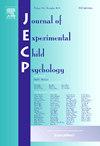Error dynamics as a marker of reading efficiency development: Insights from lexical decision performance in young readers
IF 1.8
2区 心理学
Q3 PSYCHOLOGY, DEVELOPMENTAL
引用次数: 0
Abstract
Understanding reading development requires investigating how visual word recognition capacities develop, particularly through lexical decision tasks. Traditionally, accuracy and reaction times (RTs) are analysed separately, overlooking their interaction, which provides crucial insights into performance. This study proposes a novel framework, hypothesizing that error dynamics (i.e., error distribution through RTs) could be an objective marker of reading efficiency. To test this hypothesis, the study investigated the relationship between reading skills in learning-to-read children and the dynamics of lexical decision errors. Lexical decision performance was analysed in 56 French-speaking children (22 Grade 1 and 34 Grade 2, 36 females). Two complementary methodologies were employed: RTs comparison between correct and incorrect responses and Conditional Accuracy Functions (CAFs) to evaluate accuracy as a function of RTs. Results showed that pseudoword errors were faster than correct responses whereas word errors were slower than correct responses. Of importance, fewer slow word errors and more fast pseudoword errors correlated with reading skills. The findings suggested that as reading skills improve, error dynamics would progressively shift from slow word errors to fast pseudoword errors. This study demonstrated that integrating accuracy and RTs via error dynamics analysis could provide objective markers of reading development. Crucially, it highlights a novel developmental index of reading skills through the shift of error patterns, offering a promising avenue for early identification of reading difficulties.
错误动态作为阅读效率发展的标志:来自年轻读者词汇决策表现的见解
理解阅读发展需要研究视觉单词识别能力是如何发展的,特别是通过词汇决策任务。传统上,准确性和反应时间(RTs)是分开分析的,忽略了它们之间的相互作用,而这种相互作用提供了对性能的重要见解。本研究提出了一个新的框架,假设错误动态(即通过RTs的错误分布)可能是阅读效率的客观标志。为了验证这一假设,本研究调查了学习阅读儿童的阅读技能与词汇决策错误的动态之间的关系。对56名法语儿童(22名一年级学生和34名二年级学生,其中36名女生)的词汇决策表现进行了分析。采用了两种互补的方法:正确和错误反应之间的RTs比较和条件准确性函数(CAFs)来评估作为RTs函数的准确性。结果表明,假词错误比正确反应快,而单词错误比正确反应慢。重要的是,更少的慢词错误和更多的快速假词错误与阅读技能有关。研究结果表明,随着阅读技能的提高,错误动态将逐渐从缓慢的单词错误转变为快速的假词错误。本研究表明,通过误差动力学分析将准确性和RTs结合起来,可以为阅读发展提供客观的指标。至关重要的是,它强调了一种通过错误模式转变的阅读技能的新发展指数,为早期识别阅读困难提供了有希望的途径。
本文章由计算机程序翻译,如有差异,请以英文原文为准。
求助全文
约1分钟内获得全文
求助全文
来源期刊

Journal of Experimental Child Psychology
Multiple-
CiteScore
4.50
自引率
7.70%
发文量
190
期刊介绍:
The Journal of Experimental Child Psychology is an excellent source of information concerning all aspects of the development of children. It includes empirical psychological research on cognitive, social/emotional, and physical development. In addition, the journal periodically publishes Special Topic issues.
 求助内容:
求助内容: 应助结果提醒方式:
应助结果提醒方式:


